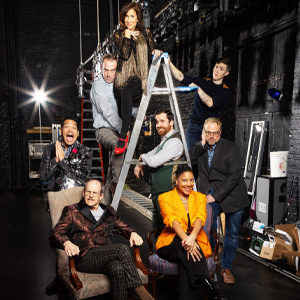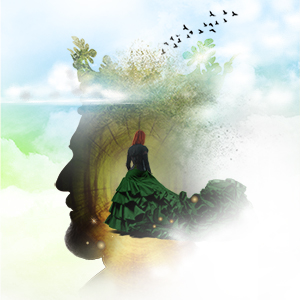By Heather Helinsky, Dramaturg
In “The Knight’s Tale,” one of Chaucer’s stories in The Canterbury Tales, two knights fight to restore the social disorder they see around them. The story swells into an epic battle over the beautiful Lady Emelye. Palamon prays to the goddess Venus that he will triumph only by winning Emelye’s love. Arcite prays to the god of war, Mars, for victory. Meanwhile, Lady Emelye prays to the goddess Diana, wishing the winning knight will be the one who loves her the most.
Ultimately, in “The Knight’s Tale” all their prayers come true in an ironic twist of fate. The knight Palamon wins Emelye’s love but loses to Arcite; Arcite wins the battle but then loses his life, as well as happiness with Emelye. While it’s a simple plot, Chaucer’s heightened poetry details lavish scenes of medieval court rituals. Chaucer gave the English reader imaginative, witty verse at a cruel time in history—the Black Plague had devastated the English population, taxes burdened the common man, endless, expensive wars with continental Europe continued, and the elite wealthy lords struggled against each other to rule England.
For a medieval poet, we know much of Chaucer’s life because of his close relationships to two Kings of England: Edward III and Richard II. King Edward III was a warrior-king who had a strong hold over England for a period of 50 years. As a boy, Chaucer apprenticed in the household of King Edward III’s second oldest son Lionel. As a teenager, Chaucer entered into the court circle and worked for the Kings of England for the rest of his life in various jobs.
Before countries honored poets with the title of ‘poet laureate’, King Edward III honored Chaucer by bequeathing him “a gallon of wine daily for the rest of his life”—perhaps the best gift any writer in history could ask for! After King Edward III’s death, King Richard II continued Chaucer’s grant, as Richard II’s love of poetry and objects of beauty is well documented.
Chaucer witnessed a tight family circle of royals at a time of great tension between the wealthy lords and the poor peasant farmers who were overly taxed to support expensive wars. At the heart of many of these conflicts were battles over inheritances and titles. Who should rule England? Did the king rule with a divine right and power from God, or should the strongest, most capable ruler guide the country?
The word of an English king, at this time, held immense powers of life and death. As Richard II matured into his reign, the circle of people he trusted grew smaller and smaller. Even though he was the rightful heir, Richard took revenge on those who challenged him, many of whom were executed or exiled. A period of his reign was known as “Richard’s tyranny,” which gave other nobles justification for taking him down in 1399.
His grandfather, King Edward III, was the patriarch of a large family. The other men in the family were John of Gaunt, the Duke of Lancaster, Edmund, the Duke of York, and Thomas of Woodstock, the Duke of Gloucester. They all had children waiting in the wings, putting pressure on King Richard II. All these noble houses would ultimately lead to England’s next war—The War of the Roses.
Richard II’s reign lasted 22 years, cut short when he was overthrown and imprisoned by his cousin Henry, the oldest son of Uncle John of Gaunt. Henry and Richard II were both born in the same year, 1367, and it’s not surprising that the two cousins were in a struggle for the throne.
Two hundred years later, Queen Elizabeth I’s reign was threatened by the Earl of Essex. Queen Elizabeth knew the parallels between her reign and Richard II, as she famously declared: “I am Richard II; know ye not that?”
It would take another poet, Shakespeare, to tell this politically dangerous story. Unlike Shakespeare’s other plays, King Richard II put his company in real danger. In 1601, the day before the Earl of Essex planned a march on London to overthrow Elizabeth, Essex paid the Lord Chamberlain’s Men 40 shillings to revive “the deposing and killing of King Richard II” at the Globe. The theatre troupe was tried for sedition, but declared innocent and escaped punishment.
Good new plays that wade into dicey politics strive to strike a balance on both sides of the issue so the audience has the opportunity to draw their own conclusions and walk away debating what the playwright was trying to say with his work. But how can a playwright write a play that represents the overthrowing of an English monarch and then perform it for the Queen of England?
Shakespeare had to walk the line. He opens the play with a mess of a situation. Richard’s government has been completely compromised by his small group of handpicked advisors, which makes his uncles and cousins jealous of their influence. There are accusations of money laundering, treason, and murder. What’s truth and what’s a lie is also difficult to discern. When is it an act of justice to overthrow a monarch? Yet do we ever really know how the playwright really feels about both sides? The answer is elusive.
When we hear the term history play,” says the production’s director Gina Lamparella, “people are afraid it will be stodgy, distant, and informative—and that’s not why we go to the theatre. And that is not this play, which is immediate, dangerous, and challenging.
“I love it when I walk out of a play and I can’t stop talking about it,” says Lamparella. “I like it when the answers aren’t all spelled out for me. King Richard II is open-ended and it can lead to some great conversations on the drive home. Who do we choose as our leader? What qualities do we want in our leaders? Then when we’re unhappy with what we’ve chosen, where do we go from there? What I’m hoping will come across in this production is that while Richard II is not right for the job, when Henry Bolingbroke takes over, he has his own problems.”
Gina Lamparella began her research on the play by watching a documentary with English actor Derek Jacobi, who described the play as “a cautionary tale for would-be despots.” Lamparella adds, “I think it’s more of a cautionary tale for the rest of us.”
As casting began for the play, Lamparella articulated what made the two cousins different from each other. “Richard II has no concept of what life is like for other people. Yet he’s honest and compelling, you want to know more about him. Richard II is the right man for the wrong job. He is a thinker, a poet-king, he loves beautiful things. If you were told as a child you were chosen by God to rule England, it would be hard to be grounded and in touch with the problems of the common man.”
Conversely, Lamparalla defines Henry Bolingbroke as clearly, “a Man of the People. He’s of noble birth, like Richard, but he’s a soldier who has come into contact with English commoners and had to lead them into battle. Henry is practical. He’s a fighter.”
“Still,” Lamparella considers, “how do we know what his real motivations are? Is Henry fighting for what he feels is right and just? Or is it more of a personal revenge against Richard for banishing him from England and taking away his inheritance in the first act of the play? How much of it is ambition? What parts of the play are his plans, and what falls into his lap because of Richard’s own political mistakes and miscalculations?
“However, Henry is a different kind of politician. He says very little, while Richard II has elegant speeches. Henry has a lot going on underneath the surface. We should see he’s constantly strategizing. What makes him a better politician is that he is able to get the support of most of the people, including the common man.”
Shakespeare gives us more of a power-struggle than these dueling cousins for the throne. In King Richard II, we see Shakespeare’s real love and pride for his country. However, if the King’s authority is challenged, it’s a play that asks, “What does it mean to be English? Where is our commonality when our core values and beliefs have crumbled?” During a war, there’s a common enemy for a nation to unite around, but during a period of civil strife, when the nation is divided by support for either Richard or Henry, what is it that unites us all?
Lamparella sees in the speech that John of Gaunt makes in the play, that by questioning Richard II’s divine right to rule, they are questioning their own belief in God, so this play is a real faith crisis—a faith crisis in patriotism.
“When there’s so much that divides us,” says Lamparella, “you have to go back and ask what is it that unites us so that the country can move forward in the world?”
If Henry and Richard are two knights locked in a more complicated battle than Chaucer’s romantic “The Knight’s Tale,” the Lady they are battling over is England. It’s in this play where we hear some of the most lyrical speeches about “This blessed plot, this earth, this realm, this England…” Chaucer’s knights may have waxed poetic about a beautiful lady; Shakespeare’s knights are in love with the rivers, forests, hills, fields, coastlines, towns and cities of their homeland.
Heather Helinsky is a DeSales Theatre grad from ’01, with an MFA in Dramaturgy from ART/Harvard in ’07. She’s a lead teaching artist in dramaturgy for The Kennedy Center, a current Barrymore Judge for Theatre Philadelphia, and a newly elected board member for the national Literary Managers & Dramaturgs of the Americas.












